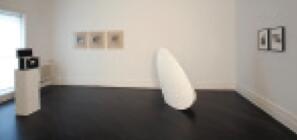Modern Negative
Henrique Faria.Fine Art New York
“Negativa Moderna” faces the viewer with a careful selection of works by fourteen Venezuelan artists, in a posthumous reflection on the legacy of the modernist project in Latin America (which Venezuela headed in the 1950s due to the wealth it derived from oil production). Although this modernist project which echoed the international principle fostering development and industrialization failed at the moment of producing substantial changes in the Venezuelan society, from the cultural point of view it continues to be a fundamental aspect of the life of the country. For we must bear in mind that part of the development of the modern State would have been impossible with- out the “nationalization” of culture.

“Negativa Moderna” (Modern Negative) takes its name from a piece by Eugenio Espinoza dated 2007/8 in which he assembles a series of works on paper and photographs that echo his work Impenetrable (1972), in which a gridlike composition in the exhibition space denied access to the visiting public. Thus, reflection on the rigidity of the modernist grid and its application from the point of view of town-planning but also from a political perspective is the axis in the case of the works displayed in the gallery’s first exhibition space. Claudio Perna’s works which explore the malleability of the grid in a series of glasses and works on paper dating from the 1970s Juan Iribarren’s canvases or Mauricio Lupini’s “penetrable diorama”, are concerned with this quadrangular structural principle. José Gabriel Fernández’s beautiful sculpture, Erotes (2009), as well as his photographs, represent the culmination of the flexibility of this apparently rigid organization.
In the second exhibition space, and after an interval in which Alessandro Balteo Yazbeck rescues some very interesting mod- ern logos (used by different Venezuelan institutions before their being replaced by a single, less “modern” and more “ethnic” one), while Javier Téllez receives the visitor with his sound installation Revolution (2000), we encounter Alexander Apóstol’s video, Documental (2005). It makes reference to the modernist project for the urban planning of Caracas, which contrasts with the housing reality of the city, surrounded by a ring of poverty constituted by shantytowns.This work holds a dialogue with Carlos Castillo’s apocalyptic video, Hecho en Venezuela (1974), where again the promises of the media and reality appear to be irreconcilable, as is also the case in Luis Molina-Pantin’s photographic work More utopic works include Nayarí Castillo’s Contemplation: Notes On Painting (2004), a delicate video in which a red flag flutters in front of a raging sea, or Mariana Bunimov’s Las Leyes del Silencio (2005), a compendium of official State Gazettes containing the country’s ordinances and civil laws. Works like Juan Araujo’s painting or Magdalena Fernández’s beautiful mobile once again refer to the grid principle which opens the show, in a cyclic response to the promises of modernity.




